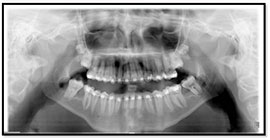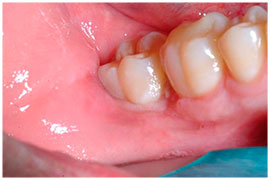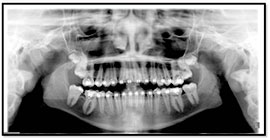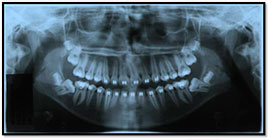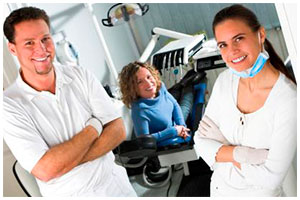
Molar uprighting corrects a tilted molar. Generally these are second molars which get caught below the back aspect of the crown of the first molar. Mandibular molars are more susceptible to develop this problem than maxillary second molars. These teeth are supposed to erupt around age twelve. Through a molar uprighting procedure, this leaning tooth can be brought back to its original position. It is a type of tooth exposure procedure but this process involves more surgery of bone and teeth than with canine exposures. Most of the time in these cases the wisdom tooth, or third molar, is above the crown of the second molar preventing the proper eruption of the second molar. It is felt that this phenomenon occurs because the proper amount of jaw development has not occurred although there are other unknown reasons that cause this as well.
Although treatment of these teeth by positioning and exposing them within the jaw bone so they can fully erupt is strictly a surgical intervention, most of these teeth when they are uprighted will not be positioned in the dental arch in their final appropriate position and therefore requiring orthodontic treatment. In fact, most patients will need braces. Sometimes a removable appliance similar to a retainer may be used. Although the molar uprighting occurs immediately after surgery, the finalization of this treatment usually takes a several months to a year since most of the time other orthodontic issues are also being resolved simultaneously.
The procedure is done under general anesthesia because of the time required and the access needed during surgery. During the uprighting procedure, the impacted wisdom tooth is first removed because this normally is obstructing the second molar. In addition, the soft tissue and gum have to be adapted and sutured appropriately around the second molar to ensure that food, bacteria and debris does not get in around the new tooth position during its healing. The bone will then grow around the roots of the tooth; this can take about three months to fill in. It is important that during this time the tooth is not moved and is also stabilized either surgically or with a brace and arch wire to make sure the bone heals around the new position of the tooth. Meticulous oral hygiene is emperative to prevent surgical infections or complications.
The patient will be asked to see the orthodontist for follow up visits about three to four weeks after the surgery. The orthodontist generally will then apply a bracket and wire to make sure there is stability during the remainder of the healing process. Once the bone has healed, orthodontic movement can be initiated to position and align the patient’s tooth in its correct location.
The risks of molar uprighting are the same as with any orthodontic procedure. There may be some discomfort or gum inflammation or disease which happens more often in people with orthodontic appliances, especially if they don't brush and floss regularly. Also, the tooth's roots may become shorter but the risk of this happening is small and usually does not cause problems. On rare occasions, though, treatment may need to be stopped if going forward will make the roots very short. Other risks include infection of the pulp requiring root canal therapy and possibly tooth decay.
